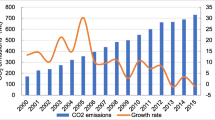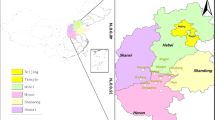Abstract
The three metropolitan regions, including **g-**-Ji (JJJ), Yangtze River Delta (YRD) and Pearl River Delta (PRD), are the most developed regions of China. This study focuses on these three metropolitan regions and tries to estimate and analyze the structure and influencing factors of CO2 emissions from transport sector, including passenger and freight transport, simultaneously covering road, rail, and water transport. The results suggest that in the period of 2000–2013, the CO2 emissions from transport sector increased from 27.8 to 198.8 Mt in JJJ, from 29.7 to 163.5 Mt in YRD, and from 13.1 to 74.0 Mt in PRD. Comparatively speaking, JJJ had the highest CO2 emission intensity of freight and urban passenger transport as well as highest transport CO2 emissions per capita and per unit GDP, while PRD had the highest transport CO2 emissions per hectare. The main challenge of reducing CO2 emissions from transport sector in these regions stemmed from freight transport and road transport. Based on decomposition analysis, economic welfare was the most important driving force of the CO2 emissions growth in all three regions, followed by transport type mix, transport dependence and modal energy intensities. In the future, low-carbon transport strategies about controlling the growth of transport demand, adjusting the transport modal structure and improving the modal energy efficiency and fuel emission efficiency are needed in all three regions, and each region should have slightly different focus. The JJJ region needs to emphasize adjusting transport modal structure, the YRD region needs to emphasize improving modal energy efficiency, and the PRD region needs to focus more on controlling the growth of transport dependence.
















Similar content being viewed by others
References
Ang, B.W.: Decomposition analysis for policymaking in energy: which is the preferred method? Energy Policy 32, 1131–1139 (2004)
Ang, B.W.: The LMDI approach to decomposition analysis: a practical guide. Energy Policy 33, 867–871 (2005)
Ang, B.W., Liu, N.: Handling zero values in the logarithmic mean Divisia index decomposition approach. Energy Policy 35, 238–246 (2007)
Bowyer, C., Skinner, I., Malins, C., Nanni, S., Baldock, D.: Low carbon transport fuel policy for Europe Post 2020. Available online at <http://www.ieep.eu/assets/1789/IEEP_TEPR_ICCT_2015_Low_Carbon_Transport_Fuel_Policy_for_Europe_Post_2020.pdf> (2015). Accessed July 20, 2015
Cai, B., Yang, W., Cao, D., Liu, L., Zhou, Y., Zhang, Z.: Estimates of China’s national and regional transport sector CO2 emissions in 2007. Energy Policy 41, 474–813 (2012)
Cheng, S., Zhang, G., Liu, M., Wu, K.: Data Availability for Measuring and Reporting Transport Related Greenhouse Gas Emissions in Chinese Cities. Institute of Comprehensive Transportation of National Development and Reform Commission of China (ICT), Bei**g (2013)
China Automotive Technology and Research Center, China Association of Automotive Manufactures.: China Automotive Industry Yearbook. China Automotive Industry Yearbook House, Bei**g (2003–2013)
Department for Transport.: Low Carbon Transport: A Greener Future. Available online at <https://www.gov.uk/government/uploads/system/uploads/attachment_data/file/228897/7682.pdf> (2009). Accessed July 20, 2015
General Office of the State Council.: Action plan about energy conservation and low carbon emissions development in 2014–2015. Available online at : <http://www.gov.cn/zhengce/content/2014-05/26/content_8824.htm> (2014). Accessed July 15, 2015
Gu, C., Hu, L., Zhang, X., Wang, X., Guo, J.: Climate change and urbanization in the Yangtze River Delta. Habitat Int. 35(4), 544–552 (2011)
Guo, B., Geng, Y., Franke, B., Hao, H., Liu, Y., Chiu, A.: Uncovering China’s transport CO2 emission patterns at the regional level. Energy Policy 74, 134–146 (2014)
Haas, J., Ban, Y.: Urban growth and environmental impacts in **g-**-Ji, the Yangtze, River Delta and the Pearl River Delta. Int. J. Appl. Earth Obs. Geoinform. 30, 42–55 (2014)
Hao, H., Geng, Y., Wang, H., Ouyang, M.: Regional disparity of urban passenger transport associated GHG (greenhouse gas) emissions in China: a review. Energy 68, 783–793 (2014)
He, K., Huo, H., Zhang, Q., He, D., An, F., Wang, M., Walsh, M.P.: Oil consumption and CO2 emissions in China’s road transport: current status, future trends, and policy implications. Energy policy 33(12), 1499–1507 (2005)
Huo, H., Zhang, Q., He, K., Yao, Z., Wang, M.: Vehicle-use intensity in China: current status and future trend. Energy Policy 43, 6–16 (2012)
IEA: CO2 Emissions from Fuel Combustion Highlights. International Energy Agency, Paris (2014)
ifeu: Transport in China: Different Transport Modes Energy Consumption and Emissions. Institute of Energy and Environment, Heidelberg (2008)
Intergovernmental Panel on Climate Change: 2006 IPCC Guidelines for National Greenhouse Gas Inventories. Institute for Global Environmental Strategies, Kanagawa (2006)
Liu, Y., Wang, Y., Huo, H.: Temporal and spatial variations in on-road energy use and CO2 emissions in China, 1978–2008. Energy Policy 61, 544–550 (2013)
Liu, Z., Geng, Y., Lindner, S., Guan, D.: Uncovering China’s greenhouse gas emission from regional and sectoral perspectives. Energy 45(1), 1059–1068 (2012)
Loo, B.P.Y., Li, L.: Carbon dioxide emissions from passenger transport in China since 1949: implications for develo** sustainable transport. Energy Policy 50, 464–476 (2012)
Loo, B.P.Y., Li, D.Y.N.: Develo** metro systems in the People’s Republic of China: policy and gaps. Transportation 33, 115–132 (2006)
Mishina, Y., Muromachi, Y.: Revisiting decomposition analysis for carbon dioxide emissions from car travel: introduction of modified laspeyres index method. Transp. Res. Rec. J. Trans. Res. Board 2270, 171–179 (2012)
National Bureau of Statistics of China.: China statistical yearbook. China Statistics Press, Bei**g (2001–2014)
Peng, B., Du, H., Ma, S., Fan, Y., Broadstock, D.C.: Urban passenger transport energy saving and emission reduction potential: a case study for Tian**, China. Energy Convers. Manag. 102, 4–16 (2015)
Schwanen, : Geographies of transport I: reinventing a field? Prog. Hum. Geogr. (2015). doi:10.1177/0309132514565725. (Published online before print Jan 13 2015)
State Council of China.: Notice of the General Office of the State Council on Comprehensive Strategies of Energy Conservation and Low Emissions. Available online at: <http://www.gov.cn/jrzg/2007-06/03/content_634545.htm> (2007). Accessed July 15, 2015
Statistical Bureau of Guangdong.: Guangdong statistical yearbook. China Statistics Press, Bei**g (2001–2014)
Tapio, P.: Towards a theory of decoupling: degrees of decoupling in the EU and the case of road traffic in Finland between 1970 and 2001. Transp. Policy 12(2), 137–151 (2005)
Tian, Y., Zhu, Q., Lai, K.H., Lun, Y.H.V.: Analysis of greenhouse gas emissions of freight transport sector in China. J. Transp. Geogr. 40, 43–52 (2014)
Wang, W., Zhang, M., Zhou, M.: Using LMDI method to analyze transport sector CO2 emissions in China. Energy 36(10), 5909–5915 (2011)
Wang, Y., Ma, W., Tu, W., Zhao, Q., Yu, Q.: A study on carbon emissions in Shanghai 2000–2008, China. Environ. Sci. Policy 27, 151–161 (2013)
Yang, W., Li, T., Cao, X.: Examining the impacts of socio-economic factors, urban form and transportation development on CO2 emissions from transportation in China: a panel data analysis of China’s provinces. Habitat Int. 49, 212–220 (2015)
Yearbook House of China Transportation and Communications.: Yearbook of China Transportation and Communications. Yearbook House of China Transportation and Communications, Bei**g (2003–2013)
Yu, H., Yang, R., Zhang, Y., Wang, S.: Study on the energy demand and environmental emissions of urban transport- a case study of Bei**g. J. Bei**g Inst. Technol. Soc. Sci. Ed. 15, 10–15 (2013). (in Chinese)
Zhang, Y., Da, Y.: The decomposition of energy-related carbon emission and its decoupling with economic growth in China. Renew. Sustain. Energy Rev. 41, 1255–1266 (2015)
Zhou, P., Ang, B.W.: Decomposition of aggregate CO2 emissions: a production-theoretical approach. Energy Econo. 30, 1054–1067 (2008)
Acknowledgements
This work was financially supported by the National Natural Science Foundation of China (No. 41701119) and the Major Program of National Social Science Foundation of China (No. 15ZDA021). The author greatly appreciates the constructive comments of the three anonymous reviewers and the editor.
Author information
Authors and Affiliations
Corresponding author
Ethics declarations
Conflict of interest
On behalf of all authors, the corresponding author states that there is no conflict of interest.
Appendix
Appendix
See Table 4.
Rights and permissions
About this article
Cite this article
Li, L. Structure and influencing factors of CO2 emissions from transport sector in three major metropolitan regions of China: estimation and decomposition. Transportation 46, 1245–1269 (2019). https://doi.org/10.1007/s11116-017-9827-6
Published:
Issue Date:
DOI: https://doi.org/10.1007/s11116-017-9827-6




